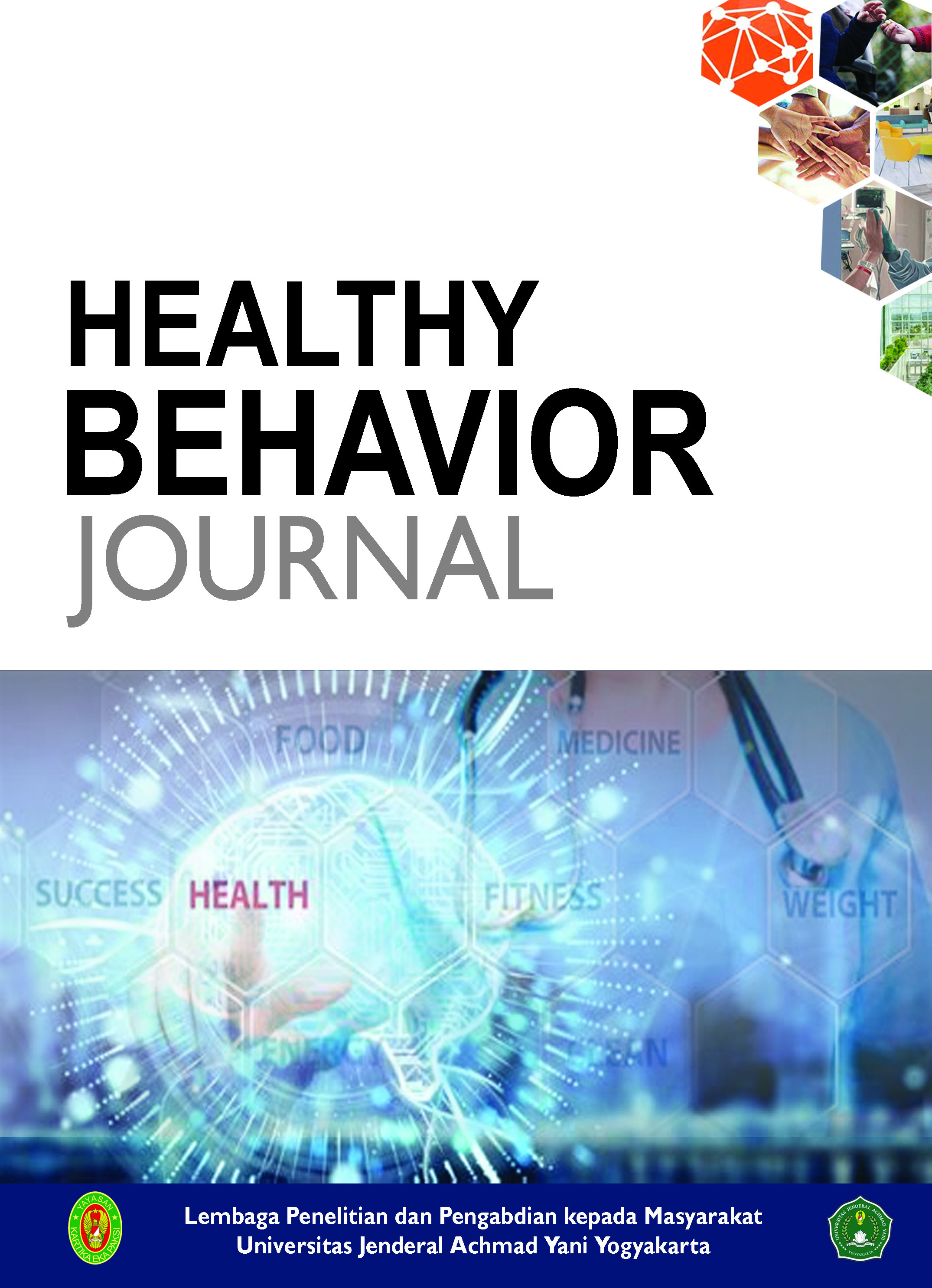Dampak Beban Family Caregiver Terhadap Perilaku Perawatan Pasien Stroke
DOI:
https://doi.org/10.30989/hbj.v3i1.1640Keywords:
Burden, Behavior, Stroke, Family caregiverAbstract
Background: Stroke prevalence in the Special Region of Yogyakarta is ranked second highest in Indonesia, with a prevalence of 14.6%. The highest prevalence is in the city of Yogyakarta at 1.50%. In cases of stroke, family caregiver s must accompany the patient for up to 24 hours to meet all the patient's needs. The role of family caregiver s aims to restore the quality of life of stroke patients and improve the therapeutic efforts of patients.
Objective: The research aims to determine the relationship between family caregiver burden and behavior in caring for stroke patients at the Yogyakarta City Hospital.
Methods: The research is quantitative with a descriptive correlative design and a crosssectional approach. The number of samples used was 39 respondents selected using purposive sampling techniques. Data collection used the Zarit Burden Interview Questionnaire and the Family caregiver Behavior Questionnaire, which have been validated and are reliable. Data analysis in this study used univariate and bivariate analysis.
Results: The results showed that family caregiver burden is related to behavior in caring for stroke patients (r=-0.335; p=0.037). The distribution of family caregiver burdens includes no burden 43.6%, light burden 51.3%, moderate burden 5.1%, while family caregiver behavior in the category of less 5.1%, family caregiver behavior in the category of sufficient 69.2%, and family caregiver behavior in the category of good 25.6%.
Conclusion: Good family caregiver behavior in caring for stroke patients has a positive impact on the patients themselves. For family caregiver s who are detected to have a high burden, it is hoped that they can consult on how to overcome it so that the quality of life of stroke patients and family caregiver s can improve.
References
Daftar Pustaka
[1] A. Yusuf, J. M. Purba, D. E. Putri, R. S. Aditya, A. Alruwaili, and D. Alrazeeni, “Family-Centered Care Experiences in Elderly With Chronic Diseases in Communities: Qualitative Study of Patients, Families, Nurses, and Volunteers,” Heal. Equity, vol. 8, no. 1, pp. 338–350, 2024, doi: 10.1089/heq.2024.0009.
[2] Q. Xu, J. Ma, Y. Zhang, and J. Gan, “Family Resilience and Social Support as Mediators of Caregiver Burden and Capacity in Stroke Caregivers: A Cross-Sectional Study,” Front. Psychol., vol. 15, 2024, doi: 10.3389/fpsyg.2024.1435867.
[3] A. Ramadia, M. Ekaputri, and S. Sumandar, “Implementasi PMR Pada Caregiver Dalam Upaya Mengurangi Kecemasan Pasien Resiko Stroke,” J. Kreat. Pengabdi. Kpd. Masy., vol. 6, no. 12, pp. 5477–5485, 2023, doi: 10.33024/jkpm.v6i12.12524.
[4] A. D. Asti, S. Novariananda, and T. Sumarsih, “Beban Caregiver Dan Stres Keluarga Pasien Stroke,” J. Ilm. Kesehat. Keperawatan, vol. 17, no. 2, p. 157, 2021, doi: 10.26753/jikk.v17i2.667.
[5] L. Rosyanti and I. Hadi, “Memahami Beban, Kondisi Psikososial Dan Koping Keluarga (Caregivers) Dalam Merawat Penderita Gangguan Jiwa (Pendekatan Keluarga),” Heal. Inf. J. Penelit., vol. 13, no. 2, pp. 165–180, 2021, doi: 10.36990/hijp.v13i2.412.
[6] B. M. Kwon et al., “Contributing Factors to the Burden on Primary Family caregiver s of Stroke Survivors in South Korea,” Int. J. Environ. Res. Public Health, vol. 20, no. 3, p. 2760, 2023, doi: 10.3390/ijerph20032760.
[7] A. Kazemi, J. Azimian, M. Mafi, K. Allen, and S. A. Motalebi, “Caregiver Burden and Coping Strategies in Caregivers of Older Patients With Stroke,” BMC Psychol., vol. 9, no. 1, 2021, doi: 10.1186/s40359-021-00556-z.
[8] Z. Liu and M. King, “The influencing factors and coping styles of mental health stress responses of stroke caregivers,” Work, vol. 69, no. 2, pp. 499–513, Jun. 2021, doi: 10.3233/WOR-213495.
[9] C.-H. Liu et al., “Burdens on Caregivers of Patients With Stroke During a Pandemic: Relationships With Support Satisfaction, Psychological Distress, and Fear of COVID-19,” BMC Geriatr., vol. 22, no. 1, 2022, doi: 10.1186/s12877-022-03675-3.
[10] M. I. H. Mukhti et al., “Family caregiver s’ Experiences and Coping Strategies in Managing Stroke Patients During the COVID-19 Pandemic: A Qualitative Exploration Study,” Int. J. Environ. Res. Public Health, vol. 19, no. 2, p. 942, 2022, doi: 10.3390/ijerph19020942.
[11] F. Qian, “Factors Influencing Caregiver Burden Among Family caregiver s of Post-Stroke Persons in Wenzhou, China,” Nurs. Heal. Sci. J., vol. 3, no. 1, pp. 24–31, 2023, doi: 10.53713/nhs.v3i1.169.
[12] M. Darussalam and S. A. Nugraheni, “Upaya Peningkatan Kualitas Hidup Pasien Post Stroke Pada Fase Rehabilitasi: Literature Review,” J. Ilmu Keperawatan Jiwa, vol. 4, no. 4, pp. 867–878, 2021.
[13] J. Wang, J. Liu, L. Li, J. Man, S. Yue, and Z. Liu, “Effect of Education and Muscle Relaxation Program on Anxiety, Depression and Care Burden in Caregivers of Acute Stroke Survivors,” Medicine (Baltimore)., vol. 100, no. 4, p. e24154, 2021, doi: 10.1097/md.0000000000024154.
[14] M. Darussalam, Z. Shaluhiyah, and B. Widjanarko, “Stroke Rehabilitation Program in Improving ADL (Activity Daily Living): Literature Review,” J. Aisyah J. Ilmu Kesehatan; Vol 7, No 4 December 2022DO - 10.30604/jika.v7i4.1289 , Aug. 2022, [Online]. Available: http://aisyah.journalpress.id/index.php/jika/article/view/7408
[15] G. Bekele et al., “Caregiver Burden and Its Associated Factors Among Primary Caregivers of Stroke Survivors at Amhara Regional State Tertiary Hospitals: A Multicenter Study,” Front. Stroke, vol. 2, 2023, doi: 10.3389/fstro.2023.1226140.
[16] R.- Rumiati, I. M. Kariasa, and A. Waluyo, “The Effectiveness of Post-Stroke Patient Care Education Intervention in Stroke Caregivers: A Literature Review,” Ijnp (Indonesian J. Nurs. Pract., vol. 5, no. 2, 2021, doi: 10.18196/ijnp.v5i2.11437.
[17] A. Nurrahima and R. D. Ariyanti, “HUBUNGAN CAREGIVER BURDEN DENGAN KUALITAS HIDUP CARGIVER ANAK TUNAGRAHITA,” J. Ilmu Keperawatan Anak, vol. 4, no. 2, pp. 47–56, 2021.
[18] F. Handayani, “HUBUNGAN PENGETAHUAN KELUARGA DAN PERILAKU KELUARGA PADA PENANGANAN AWAL KEJADIAN STROKE.” faculty of medicine, 2019.
[19] G. Sohkhlet et al., “Stress in Caregivers of Stroke Patients During Rehabilitation: An Observational Study,” Cureus, 2023, doi: 10.7759/cureus.37410.
[20] E. Tziaka et al., “A Holistic Approach to Expressing the Burden of Caregivers for Stroke Survivors: A Systematic Review,” Healthcare, vol. 12, no. 5, p. 565, 2024, doi: 10.3390/healthcare12050565.
[21] P.-W. Chen, N. A. Baune, I. Zwir, J. Wang, V. Swamidass, and A. W. K. Wong, “Measuring activities of daily living in stroke patients with motion machine learning algorithms: A pilot study,” Int. J. Environ. Res. Public Health, vol. 18, no. 4, pp. 1–16, 2021, doi: 10.3390/ijerph18041634.
[22] S. Na’imah, C. Effendy, and S. Supriyati, “Burden of Family caregiver in Caring for Stroke Patients: A Mixed Method Research,” J. Keperawatan Respati Yogyakarta, vol. 10, no. 01, p. 17, 2023, doi: 10.35842/jkry.v10i01.721.
[23] J.-W. Lee et al., “Predictors of Burden for First-Ever Stroke Survivor’s Long-Term Caregivers: A Study of KOSCO,” Medicina (B. Aires)., vol. 60, no. 4, p. 559, 2024, doi: 10.3390/medicina60040559.
[24] K. K. Dharma, D. Damhudi, N. Yardes, and S. Haeriyanto, “Caregiver Empowerment Program Based on the Adaptation Model Increase Stroke Family caregiver Outcome,” Front. Nurs., vol. 8, no. 4, pp. 419–427, 2021, doi: 10.2478/fon-2021-0042.
[25] M. Darussalam and F. Ferianto, “Electronic-Module Range of Motion on Family caregiver s in Increasing Muscle Strength in Stroke Sufferers,” J. Kesehat. Masy., vol. 20, no. 3, pp. 596–602, 2025.
[26] T. A. R. K. Putri, W. Ramadita, E. Supriatin, and S. N. Hayati, “Psychoeducational Intervention for Family caregiver Burden in Stroke Patients Care,” Risenologi, vol. 7, no. 1a, pp. 21–25, 2022, doi: 10.47028/j.risenologi.2022.71a.327.
[27] U. M. Khanapur, J. John, A. M. Mani, and S. Aaron, “Predictors of Caregiver Burden of Moderate and Severe Stroke Survivors: A Cross-Sectional Study From South India,” J. Stroke Med., vol. 4, no. 1, pp. 34–43, 2021, doi: 10.1177/2516608520980547.
[28] R. Gaur, S. Asthana, N. M. Gonnade, A. Ranjan, and D. Morvadiya, “Repercussions of Caregiving on Caregivers of Stroke Survivors: A Cross-Sectional Study,” Cureus, 2023, doi: 10.7759/cureus.51250.
[29] W. M. A. W. A. Rahman and M. Mazlan, “The Prevalence of Depression and Its Correlates Among Informal Caregivers of Stroke Patients in an Urban Community,” Cureus, 2024, doi: 10.7759/cureus.51486.
[30] C. J. Shamoun and M. Harris, “Impact of Stroke Survivors’ Physical Disability on the Presence of Caregiver Burden: A Systematic Review,” J. Neurosci. Nurs., vol. 54, no. 4, pp. 146–150, 2022, doi: 10.1097/jnn.0000000000000651.
[31] T. Farombi, H. T. A. Khan, and M. Lawal, “Exploring the Experiences of Family caregiver s in the Management of Stroke Among the Older Adults in Nigeria: A Qualitative Study,” J. Popul. Ageing, vol. 17, no. 4, pp. 679–691, 2024, doi: 10.1007/s12062-024-09454-9.
[32] S. Mulyani and M. Darussalam, “Hubungan Ketergantungan Activity Daily Living Penderita Stroke dengan Beban Family caregiver di Puskesmas Kasihan II,” 2023.
[33] J. Zhao et al., “Effect of Main Family caregiver ’s Anxiety and Depression on Mortality of Patients With Moderate-Severe Stroke,” Sci. Rep., vol. 11, no. 1, 2021, doi: 10.1038/s41598-021-81596-8.
[34] M. Zeeshan, S. Shaikh, and Z. Ahmer, “How Frequent Is Burnout Among Informal Caregivers of Disabled Children? Findings From a Cross‐sectional Study in Karachi, Pakistan,” Child Care Heal. Dev., vol. 48, no. 3, pp. 415–422, 2021, doi: 10.1111/cch.12941.
[35] P. Sharifian, F. Mohammadi, F. Ranjbaran, N. Kamyari, and M. Shamsizadeh, “The Effects of Care-Oriented Group Discussion on Burnout Among the Caregivers of Patients With Stroke,” J. Multidiscip. Care, vol. 10, no. 3, pp. 121–125, 2021, doi: 10.34172/jmdc.2021.24.
[36] D. F. do Canto, F. M. da Costa, A. de F. Lucena, and L. M. G. Paskulin, “Educational Intervention for Family caregiver s of Older Adults After Stroke: Pragmatic Trial Protocol,” Rev. Bras. Enferm., vol. 78, no. 1, 2025, doi: 10.1590/0034-7167-2024-0234.
[37] H. B. Ardalan, S. A. Motalebi, A. Shahrokhi, and F. Mohammadi, “Effect of Education and Telephone Follow-Up on Care Burden of Caregivers of Older Patients With Stroke,” Salmand, vol. 17, no. 2, pp. 290–303, 2022, doi: 10.32598/sija.2022.2183.3.
[38] K. Kang and S. Li, “A WeChat-based Caregiver Education Program Improves Satisfaction of Stroke Patients and Caregivers, Also Alleviates Poststroke Cognitive Impairment and Depression: A Randomized, Controlled Study,” Medicine (Baltimore)., vol. 101, no. 27, p. e29603, 2022, doi: 10.1097/md.0000000000029603.









